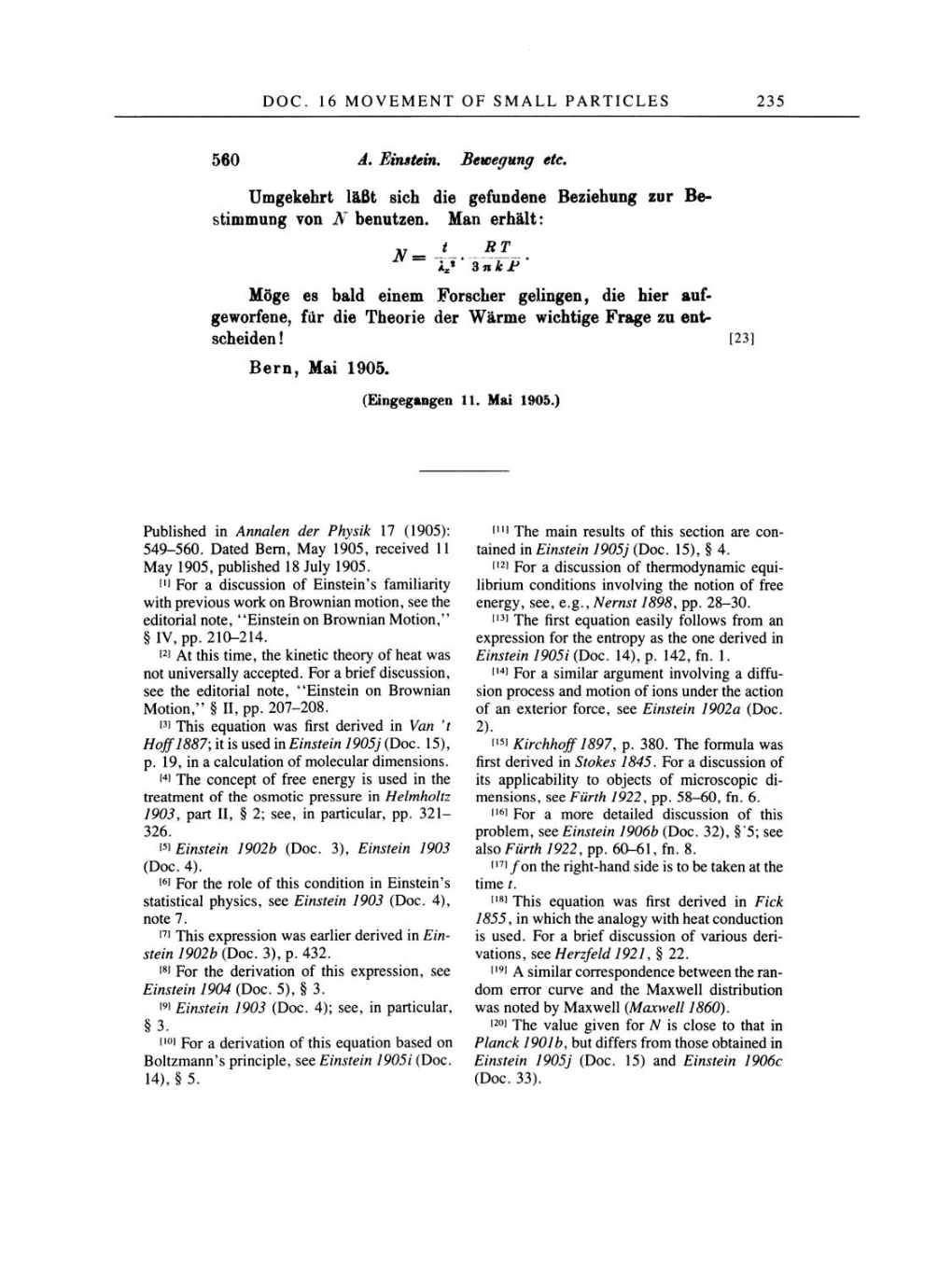DOC.
16
MOVEMENT OF SMALL PARTICLES 235
560
A.
Einstein.
Bewegung
etc.
Umgekehrt
läßt
sich die
gefundene
Beziehung
zur
Be-
stimmung von
N
benutzen.
Man
erhält:
v_
Rl-
V
'
Snkf*
Möge
es
bald einem
Forscher
gelingen,
die hier auf-
geworfene,
für die Theorie der Wärme
wichtige
Frage
zu
ent-
scheiden!
[23]
Bern,
Mai
1905.
(Eingegangen 11.
Mai
1905.)
Published in Annalen
der
Physik
17
(1905):
549-560.
Dated
Bern,
May
1905,
received
11
May
1905,
published
18
July
1905.
[1]
For
a
discussion
of Einstein's
familiarity
with
previous
work
on
Brownian
motion,
see
the
editorial
note,
"Einstein
on
Brownian Motion,"
§
IV,
pp.
210-214.
[2]
At this
time,
the kinetic
theory
of
heat
was
not
universally accepted.
For
a
brief
discussion,
see
the editorial
note,
"Einstein
on
Brownian
Motion,"
§
II,
pp.
207-208.
[3]
This
equation was
first derived in
Van
't
Hoff
1887;
it
is
used in Einstein
1905j (Doc.
15),
p.
19,
in
a
calculation
of
molecular dimensions.
[4]
The
concept
of
free
energy
is
used in the
treatment
of
the osmotic
pressure
in
Helmholtz
1903,
part
II,
§
2; see,
in
particular,
pp.
321-
326.
[5]
Einstein
1902b
(Doc. 3),
Einstein 1903
(Doc. 4).
[6]
For the
role
of
this condition in
Einstein's
statistical
physics, see
Einstein 1903
(Doc. 4),
note
7.
[7]
This
expression was
earlier derived in Ein-
stein 1902b
(Doc.
3),
p.
432.
[8]
For the derivation
of
this
expression, see
Einstein 1904
(Doc. 5),
§
3.
[9]
Einstein
1903 (Doc. 4); see, in particular,
S
3.
[10]
For
a
derivation
of
this
equation
based
on
Boltzmann's
principle,
see
Einstein 1905i
(Doc.
14),
§
5.
[11]
The main results
of
this section
are con-
tained in
Einstein
1905j
(Doc. 15),
§
4.
[12]
For
a
discussion
of
thermodynamic equi-
librium conditions
involving
the notion
of
free
energy, see, e.g.,
Nernst
1898,
pp.
28-30.
[13]
The first
equation easily
follows from
an
expression
for the
entropy as
the
one
derived in
Einstein
1905i
(Doc. 14),
p.
142,
fn.
1.
[14]
For
a
similar
argument involving a
diffu-
sion
process
and motion
of
ions under the
action
of
an
exterior
force,
see
Einstein 1902a
(Doc.
2).
[15]
Kirchhoff
1897, p.
380. The formula
was
first derived in Stokes 1845. For
a
discussion
of
its
applicability
to
objects
of
microscopic
di-
mensions,
see
Fürth
1922,
pp.
58-60,
fn.
6.
[16]
For
a more
detailed discussion
of
this
problem,
see
Einstein 1906b
(Doc. 32), §.5;
see
also
Fürth
1922,
pp.
60-61, fn.
8.
[17]
f
on
the
right-hand
side
is to
be taken
at
the
time
t.
[18]
This
equation was
first derived in
Fick
1855,
in which the
analogy
with heat conduction
is
used. For
a
brief
discussion
of
various deri-
vations,
see Herzfeld
1921,
§
22.
[19]
A similar
correspondence
between the
ran-
dom
error curve
and the Maxwell distribution
was
noted
by
Maxwell
(Maxwell 1860).
[20]
The value
given
for N
is
close to that in
Planck
1901b, but differs from those obtained in
Einstein
1905j
(Doc.
15)
and Einstein 1906c
(Doc. 33).
